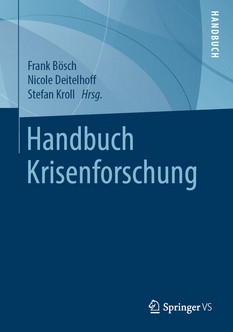Main Content
A Manual for Crisis Research

Our perception of the world has been shaped by crises and crisis diagnoses for some time. But what kind of research on crises is needed? No scientific discipline alone can shed light on the complex dynamics of crises. That is why the Leibniz Research Alliance "Crises in a Globalised World", of which the IRS is a member, has been working on interdisciplinary approaches to crisis research since 2013. A new handbook is a central joint product of the research network. IRS scholars contributed three articles to the anthology.
In the research network, 24 Leibniz Institutes from almost the entire disciplinary spectrum of the Leibniz Association work together to better understand the mechanisms and dynamics of crises and their mutual interdependencies in an interdisciplinary and transdisciplinary manner. The “Handbuch Krisenforschung” (“Crisis Research Handbook”), published in 2020, examines a key concept in the humanities and social sciences in an interdisciplinary manner. It elaborates the state of research on crises as situations of political action for various fields and at the same time emphasises the close connection to political practice that can be observed in the use of the concept of crisis. While research on individual crisis events and phenomena is part of the daily business in many disciplines, overarching conceptual considerations on crises are usually limited to organisational aspects of crisis management or to crisis discourses. Following on from these states of research, but pointing beyond them, the handbook deals with crisis research from various conceptual and methodological perspectives, arguing for a reflexive approach that understands the concept of crisis itself as a concept to be observed.
The volume is edited by Frank Bösch (Centre for Contemporary History Potsdam), Nicole Deitelhoff and Stefan Kroll (both Peace Research Institute Frankfurt) . In his introductory chapter, Stefan Kroll argues for "reflexive crisis research": It should consider the factual side of threats, but also the dimension of perception and crisis-related action. In this way, the concept of crisis will serve less as an objective category for certain types of events than as a focus of observation for the way real dangers and the way they are dealt with relate to each other in a typical - i.e. crisis-like - way. The volume is structured in three parts: Part I deals with concepts of crisis. Part II deals with the time dimension, with the course and tempo of crises. It also looks at the interdependence of different dynamics and the connection between temporality and spatiality in crises. Part III examines different fields of crisis and their specific dynamics. Finally, Part IV deals with structures for managing crises.
Contributions from the IRS contribute to Parts II and IV of the volume: In the chapter "On the Spatiality of Crises", Verena Brinks and Oliver Ibert bring to the fore the aspect of the spatiality of crises, which has so far been rather neglected. In doing so, they address four different but mutually influential perspectives on spatiality: relationality, territoriality, scalarity and topology. Also in Part II, Heiderose Kilper discusses the interdependence of crises in a globalised world. While crises always painfully remind us of the interdependence of different spheres of society, she argues, in a globalised world the aspect of transnationality is added. Finally, in their chapter on expert consultants (Part IV), Verena Brinks and Oliver Ibert discuss the interplay of different types of expert knowledge in crises. With their distinction between experts in crises and experts for crises, they make clear that expertise is mobilised in very different ways in crises, each with its specific relevance, but also its limitations.


